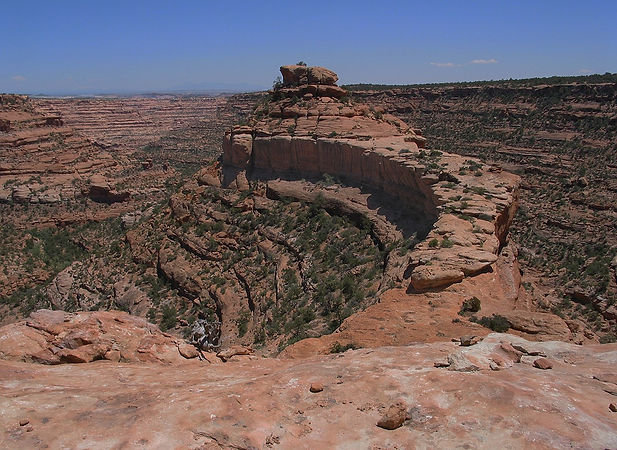
Citadel Ruin Pastel on paper Akiko Hirano
Entanglement
Akiko Hirano & Tim Wong
Winter, 1270 AD. A new moon cast faint shadows over the landscape on this bitterly cold night. Restless One had been crouching hidden behind a large boulder, watching the narrow rock spine connecting his pueblo with the mesa to the west. Years of persistent drought had turned friendly clans into enemies, farmers into raiders. Amid escalating violence, many had left the area. His family tried to hang on, relying on the supremely defensive locale of their pueblo, hidden behind a rock tower accessible only via a narrow ridge with vertical cliffs on both sides. Knowing the raiders chose to attack on moonless nights, he had not slept the past two nights. He was tired.
Restless One was jerked awake by commotion from the pueblo. He grabbed his stone hammer and raced towards the noise and found his sons and wife locked in mortal combat with several intruders. He swung his hammer at the nearest man, cracking his skull and the hammer handle instantly. A second intruder let go of Restless One’s wife and turned to lunge at the husband. At the same instant, the wife picked up a heavy metate and smashed it over the man’s head. The man crumpled to the ground, followed by the metate, split in half on impact. Seeing that they lost their leader, the other raiders retreated and fled towards the mesa, leaving Restless One holding his gravely injured wife, as the moon slipped behind the mesa.

The peninsula Photo Tim Wong
Fall, 2004 AD. At 33,000 ft above the Pacific Ocean, she opened the book picked up before boarding the flight to Tokyo. She read about an Anasazi ruin somewhere in Southern Utah, hidden behind a rock tower accessible only via a narrow rock ‘peninsula’. I have to find that ruin, she closed the book and thought to herself. That winter, she pored over topographical maps looking for geographic features that matched the description of the peninsula. On one of the maps, she penciled in an ‘X’ and a question mark next to a bunch of tightly crowded contour lines.
One sunny morning the following spring found her walking briskly on a juniper-covered mesa, miles from any road, heading towards the X symbol on her map. At the abrupt end of the mesa, she caught herself crying out in elation. In front of her, a long narrow spit of rock spine snaked out like a giant question mark towards a tall pinnacle. She knew she had found the peninsula. For the next several hours, she tried to find a way to get onto that rock spine but was stopped repeatedly by steep drop-offs. Finally, she discovered a circuitous route with acceptable degree of exposure. Moments later, she was walking on the peninsula.
The peninsula was a flat-top ridge of bare rock with no vegetation, flanked by vertical drop-offs on both sides. It was impossible to approach the pinnacle unnoticed. She climbed over remnants of a stone barrier and walked to the far end. No sign of any ruin. She circled behind the pinnacle and looked up, there it was – a group of perfectly preserved rooms hidden under the caprock, totally invisible from the mesa.
Guarding the approach to the rooms was a large boulder with peep holes for keeping watch over the peninsula. She scrambled onto a natural rock platform past that boulder and came face-to-face with a series of rooms built with stones and mortar, each with a doorway, some also had a window. The first two rooms were small and the interiors were plastered in white. Wooden sticks were built into the walls to serve as hangers. Most amazing, a perfectly preserved window frame was made from wooden sticks tied together with twines to form a flat plank. She couldn’t help but admired the ingenuity and workmanship of the builders. Towards the far end of the complex, she found a larger room with a blackened ceiling and exhaust holes on the upper wall. A rectangular niche in the corner might serve as a firebox. Anasazi corncobs littered the dirt floor. It was the food preparation area.
Behind the pinnacle, she found a chimney that led to the top of the caprock. She shinnied up onto the caprock and found a pile of stones, remains of a low wall for hiding to watch over the approach peninsula. Shallow basins were cut into the bedrock to catch rain water. A sizable tree somehow found enough moisture to grow on top of the caprock. Hearing distant thunder, she turned and saw rain clouds forming over Comb Ridge. She sat down to watch the clouds approaching from the east; she had a panoramic view of the surrounding canyons, with the Sleeping Ute Mountain on the horizon far away. What a spectacular site this was!
When the storm pressed closer, throwing deafening lightning bolts, she suddenly realized she was on a perfect target for lightning strikes. She hastily climbed down the chimney and moved away from the caprock. Looking around, she found a depression to squat down to ride out the storm. That was when she noticed an oblong gray stone with polished edges on the ground. Not far from that stone lay two heavy rock slabs. She turned the slabs over to line them up and realized they were two halves of a broken metate. This must be a prized possession of an Anasazi woman; somehow, she sensed tragedy happened here. She picked up the gray grinding stone, which fit perfectly in her hand, and placed it carefully on top of the metate, as fat drops of rain started to pelt down.
